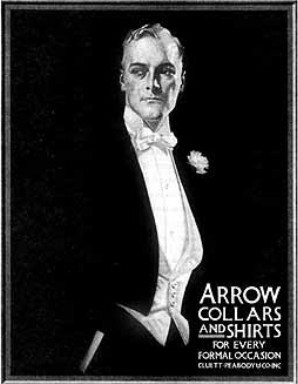The Arrow Collar Man
The Arrow Collar Man was a cultural icon and a symbol of the ideal American male, epitomized through a series of advertisements for Arrow shirts and collars produced by the Cluett Peabody & Company. Created by J.C. Leyendecker, one of the pre-eminent illustrators of the early 20th century, the Arrow Collar Man represented the epitome of masculine elegance and sophistication from the 1900s to the 1930s.
Background[edit | edit source]
The Arrow Collar Man campaign was launched in the early 1900s, at a time when America was undergoing significant social and economic changes. The campaign tapped into the aspirations of the American middle class, who were keen on emulating the aristocratic lifestyles of the wealthy elite. Through the illustrations of J.C. Leyendecker, the Arrow Collar Man became an aspirational figure, embodying the qualities of refinement, charm, and success.
J.C. Leyendecker and the Creation of the Arrow Collar Man[edit | edit source]
J.C. Leyendecker, a German-American illustrator, was the artistic genius behind the Arrow Collar Man. Leyendecker's distinctive style, characterized by its bold lines, sophisticated color palette, and idealized figures, was perfectly suited to the creation of an icon that would capture the public's imagination. Leyendecker's illustrations often featured his own partner, Charles Beach, as the model for the Arrow Collar Man, further adding to the allure and mystique of the character.
Cultural Impact[edit | edit source]
The Arrow Collar Man quickly became a national sensation, with millions of American men aspiring to emulate his style and demeanor. The campaign is credited with revolutionizing men's fashion advertising by focusing on the image of the ideal man, rather than simply the product being sold. This approach not only boosted sales of Arrow shirts and collars but also had a lasting impact on advertising strategies in the fashion industry.
Moreover, the Arrow Collar Man had a significant influence on societal perceptions of masculinity. At a time when masculinity was undergoing a transformation, the Arrow Collar Man offered a vision of manhood that was both modern and rooted in traditional values of elegance and sophistication. This duality made the Arrow Collar Man a timeless figure, whose appeal transcended the era of his creation.
Legacy[edit | edit source]
The legacy of the Arrow Collar Man endures to this day. He remains a symbol of the power of advertising to shape cultural norms and ideals. The campaign is studied in marketing, fashion, and cultural studies courses as an example of early 20th-century advertising excellence. Furthermore, J.C. Leyendecker is celebrated for his contributions to American art and advertising, with the Arrow Collar Man being one of his most enduring legacies.
The Arrow Collar Man also paved the way for future advertising icons and campaigns that seek to capture the essence of an ideal consumer through a compelling character. His influence can be seen in the creation of other advertising icons and in the continued importance of brand mascots in connecting with audiences.
See Also[edit | edit source]
Search WikiMD
Ad.Tired of being Overweight? Try W8MD's physician weight loss program.
Semaglutide (Ozempic / Wegovy and Tirzepatide (Mounjaro / Zepbound) available.
Advertise on WikiMD
|
WikiMD's Wellness Encyclopedia |
| Let Food Be Thy Medicine Medicine Thy Food - Hippocrates |
Translate this page: - East Asian
中文,
日本,
한국어,
South Asian
हिन्दी,
தமிழ்,
తెలుగు,
Urdu,
ಕನ್ನಡ,
Southeast Asian
Indonesian,
Vietnamese,
Thai,
မြန်မာဘာသာ,
বাংলা
European
español,
Deutsch,
français,
Greek,
português do Brasil,
polski,
română,
русский,
Nederlands,
norsk,
svenska,
suomi,
Italian
Middle Eastern & African
عربى,
Turkish,
Persian,
Hebrew,
Afrikaans,
isiZulu,
Kiswahili,
Other
Bulgarian,
Hungarian,
Czech,
Swedish,
മലയാളം,
मराठी,
ਪੰਜਾਬੀ,
ગુજરાતી,
Portuguese,
Ukrainian
Medical Disclaimer: WikiMD is not a substitute for professional medical advice. The information on WikiMD is provided as an information resource only, may be incorrect, outdated or misleading, and is not to be used or relied on for any diagnostic or treatment purposes. Please consult your health care provider before making any healthcare decisions or for guidance about a specific medical condition. WikiMD expressly disclaims responsibility, and shall have no liability, for any damages, loss, injury, or liability whatsoever suffered as a result of your reliance on the information contained in this site. By visiting this site you agree to the foregoing terms and conditions, which may from time to time be changed or supplemented by WikiMD. If you do not agree to the foregoing terms and conditions, you should not enter or use this site. See full disclaimer.
Credits:Most images are courtesy of Wikimedia commons, and templates Wikipedia, licensed under CC BY SA or similar.
Contributors: Prab R. Tumpati, MD

